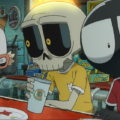Quarantine Control #76: The Nomadic Fahrenheit Case Is in Jeopardy

Yes, the COVID-19 situation remains what you could call “not good,” but what boils down to a vaccine mandate could be just what we need to advance closer to a sort-of “end” of the pandemic. Right-wingers freaking the hell out about this being a power grab and literal tyranny, the kind of deranged takeaway expected from these kinds of people nowadays. Even if it reaches the courts, and potentially the hacks on the US Supreme Court, this could push people to get vaccinated in the meantime. This is the most optimistic lede here in a while, and hopefully it sticks.
Geoffrey Barnes
Megalo Box & Megalo Box 2: Nomad
Source: Funimation
Episodes: 26 (Both seasons are 13 episodes each)

You don’t have to be involved in making a spiritual successor to a beloved work (series, movie, etc.) to know it’s a difficult undertaking. Take Megalo Box, a spiritual successor to one of the most beloved manga and anime series in Japan’s history: Ashita no Joe. The idea here was to create a series that was at least close to as memorable as the predecessor, though not by doing the same thing again. It keeps the core concepts of being about boxing and following the lives of the boxers themselves, albeit with the fighters using legal enhancements and equipment, but it needed characters with stories as emotionally intriguing as those from its predecessor. It’s good, then, that it succeeds in accomplishing those goals, especially in the second season.
The Megalo Box seasons take place in a dilapidated Japan made to mimic the post-World War II feel of the country from the original franchise, but now in the kind of dystopia easy to envision in a late-stage capitalist universe. The protagonist is a man with no name who later takes up the name “Joe” when he enters Megaloboxing, at the behest of trainer and manager Gansaku Nanbu.
Joe begins by using the same kinds of enhancements other Megaloboxers use aesthetically, which improve offense and defense on the parts the armor covers, though to throw matches while making the losses look real to satisfy the mobsters higher up the chain. But Joe eventually goes without them to make a name for himself as Gearless Joe when he starts taking boxing seriously, and enters the Megaloboxing tournament. He’s primarily gearing up for an eventual fight with Yuri, who’s sponsored by Yuriko Shirato (a blatant stand-in for Ashita no Joe’s Yoko Shirato) of the Shirato Group megacorp.
What makes the fights and series progression for the first season intriguing is how going gearless immediately puts Joe at a perceived disadvantage, compared to every other character who isn’t crazy enough to go without gears. This raises the stakes and creates an underdog story, and, thus, an interesting tale.
The first season is never boring, and remains entertaining for its 13-episode duration, but gets a little predictable after it becomes clear that Joe will tough the fights out against opponents despite the initial challenges. But I have to emphasize the “little” in that last sentence, because it ends with a hell of a twist for anyone familiar with Ashita no Joe’s conclusion. (I envy you if you’re not familiar with it by now.) It was no longer a “twist” when it received a second season, but the result remains entertaining enough that you shouldn’t look up how it ends before watching the series.
It’s the second season, Nomad, where things get more exciting. The first season’s ending felt unnaturally rosy compared to where Ashita no Joe went, though not ill-fittingly so. The second season serves as an immediate reminder that the series’ universe is a dystopia, and it doesn’t take long for things to go horribly awry after seeming largely fine when the first season concluded. Five years after the original series’ end, Joe has crashed hard and is living the life of a nomad (hence the subtitle) wandering from one arena to the other, with the series filling in the reasons why and the further trouble Joe gets into over its duration.
The first Megalo Box was too bound to the status of a spiritual successor, seemingly afraid to break away from a set formula. The thing is, these flaws didn’t become apparent until watching the second season, the progression and flow in which is more unpredictable while still inheriting the feeling of Ashita no Joe. It’s even more morbid and depressing right from the first episode and largely stays that way, but remains a true spiritual successor by not trying too hard to depress the audience.
It does so while adding a more Latin flavor by partially focusing on characters who are Hispanic immigrants, a sign that the producers were fully aware of how popular the first season was among Latin and Latin-American communities. This series understood the plight of undocumented immigrants better than many other shows, beyond anime. It helped that the producers watched a bunch of Latin-focused media before taking on this series, like Netflix’s Narcos, but the praise for its character development is nonetheless warranted.
The animation and art style are both sublime for a certain type of anime fan. The Megalo Box seasons are spiritual successors to the point of mimicking the animation look common in 1970s, 1980s, and early 1990s anime, containing a palette with muted colors and a gritty style. It works for the subject matter, and the people it’s aimed towards. The existence of this show and the fact that it received two seasons is proof enough that an audience exists for anime made in a similar style to those from the so-called good-old days of Japanese animation.
There’s a part of me curious as to whether the producers are brave enough to take on a third season, something I can ask without spoiling anything thanks to the presence of multiple boxers that a follow-up could focus on. They fortunately had the wisdom to not put anyone’s name in the title, which leaves them the opportunity to continue it without the current central characters. Whether they’ll do so depends on the next time TMS Entertainment isn’t busy with more Lupin III or adapting more Dr. Stone, among other work. There’s also the possibility of another spiritual successor or new property that I can’t predict. Either way, the team responsible for this series deserves more work, regardless of the studio they produce content with.
Angela Moseley
At the rate we’re going with the pandemic I can easily see Quarantine Control #100 happening. Cases may be flattening out, but deaths are still way too high and we are fast approaching a grim milestone of 700,000 Americans dead. And we’ve had vaccines available for months now. Should anyone be surprised about vaccine mandates? The fun part will be all of the lawsuits coming as a result. Why fight a pandemic when you can just pretend it doesn’t exist?
Fahrenheit 9/11 (2004)
Source: YouTube (I rented it, but there are free uploads)
Episodes: 1 Documentary

When I was writing my super-long, totally not backdated 9/11 retrospective, my husband suggested I try watching Fahrenheit 9/11. As old as this documentary is, I never bothered to sit down and watch it. I wasn’t sure what to expect. Was it a 9/11 truther work or something else? Thankfully, Michael Moore’s work turned out to be something else entirely. Also, much of the documentary lost its punch for me since I’d learned about much of what Moore investigated through other media sources such WNYC’s Blindspot the Road to 9/11.
Fahrenheit 9/11 is an investigative journalism piece that actually has more do with criticism of the administration of George W. Bush and the Iraq war rather than 9/11 itself. The title of the documentary is a play on the title of Ray Bradbury’s dystopian novel Fahrenheit 451. Moore documents the highly contested 2000 election, including evidence of fraud, that evidence being ignored and the Supreme Court ultimately deciding the election. He then notes Bush’s low approval ratings in early 2001 and how much time the president spent on vacation at his Crawford, Texas residence. This all leads to the failure of the Bush administration to take intelligence reports about a possible attack seriously. When the events of 9/11 unfold, Moore notes the connections between the Bush family and influential Saudi Arabia families. This is actually timely, given the recently declassified reports of communications of Saudi individuals with some of the 9/11 hijackers. (The Saudi government has always denied taking any part of the events that unfolded that day.)
Moore also notes the administration’s half-assed efforts in Afghanistan and the drumbeat to pivot resources to starting a war in Iraq in 2002 and 2003. Not because of any effort to avenge what happened on 9/11, but because of vested business interests. This is indeed what happened after Iraq fell and businesses protected by the military began their operations. He also investigated Bush and Vice President Dick Cheney’s vested interest in corporations that had to do with oil or energy. The documentary also doesn’t spare major media outlets that were complicit in spreading what amounted to propaganda from the administration without doing much in terms of their own investigations.
Finally, Moore wraps the documentary by showing how the decision to attack Iraq not only affected the country and the people living there, but how it affected Americans as well. Poor and disadvantaged Americans were asked to bear the brunt of war by enlisting as soldiers while members of congress did not have to worry about sending their children off to war. In fact, at the time of the documentary the only member of congress to send a child of theirs off to war was Senator Joe Biden.
Again, I came to this documentary a little too late to appreciate what Moore had to say about the Bush administration’s business and political connections and how they used them after 9/11. However, I did appreciate the balancing of comedy and somberness in a documentary that dared to speak out against the Bush administration at the height of its popularity. Also, considering how controversial the Trump administration was, it might be tempting to go back and idolize the Bush administration. Fahrenheit 9/11 is a good reminder on why those rose colored glasses aren’t so rosy. Many of Trump’s policies weren’t very ideologically different from Bush’s. It’s just that the 43rd President of the United States was better at keeping the cynical parts quiet. In terms of the Iraq and Afghanistan wars, every administration since Bush has handled the situation quite callously.
Sometimes it takes a documentary to serve as a great reminder of past recent history since memories tend to fade over time.
Joseph Daniels
I am getting pretty tired of hearing about people complaining that they don’t want to wear a mask, then wondering why COVID-19 is still around. I’ve been wearing my mask since before mask mandates even started and I got both my shots. It’s not on me that this thing is still around, it’s on you uneducated conspiracy mongers for keeping it going. You’d rather listen to Karen on YouTube because she confirms your own misguided biases rather than actual peer reviewed science.
And now Alberta has gone from “COVID is over! Let’s just get back to our lives and see where the dice fall,” to “State of emergency… we’re in a desperate health crisis and need to dig ourselves back out,” in two short months, and literally everyone else in Canada could’ve told them that was going to be the end result. Are they going to learn from this? Debatable. Instead of proving the conspiracy mongers wrong, they’re circulating a whole new set of theories now. You can do that however much you like, Alberta, but stay on your side of the border when you do that, please.
I swear, Alberta for us Canadians is like the deep south for Americans. It’s pretty much the most redneck, far right province we’ve got.
Pretty Hard Cases (2021)
Source: CBC Gem (Canada; sorry Americans)
Episodes: 10; second season confirmed

A new cop show in this day and age is going to be a pretty tough sell, but I feel like Pretty Hard Cases hits most of the right notes. It follows Meredith MacNeill as Detective Sam Wazowski from the guns and gangs department of the Toronto Police, and Adrienne C. Moore (you might recognize her from Orange is the New Black) as Detective Kelly Duff from the drug squad as they find their investigations starting to overlap.
The pair end up teaming up to try to take down the Stockwood gang, which after the first episode of the season, has just been taken over by Twilight Sparkle from My Little Pony: Friendship is Magic, the original Bubbles from The Powerpuff Girls and Dil Pickles from Rugrats. No, I’m serious, Tara Strong plays Tiggy Sullivan, and she can do villainous roles very well, it turns out.
One thing I appreciated about the series was that it highlighted some of the injustices present in police departments, like when Duff blew the whistle on one of her fellow officers in the drug squad and it ended with her having to leave the squad entirely. Sadly, this is all too real, for when good cops blow the whistle on bad cops, there really is an old boys club that bands together to ostracize the good cop and drive them off of the force entirely. This is how come things like the killing of George Floyd happen, because good cops are too scared to say anything, and when they justify their inactions in their own heads, they begin the downward slide into becoming bad cops. Rotten apples really do spoil the whole barrel.
I appreciated that, as a cop show, it wasn’t obsessed with always solving murders, which is pretty much the only crime that gets investigated in cop fiction outside of Law & Order: Special Victims Unit. One thing that was pointed out to me by a friend who watched it with me was that it persisted in making the same blanket statements on how good the war on drugs is that everything else has done. The war on drugs disproportionately affects minorities, and even if a white person is convicted of drug crimes, they’re usually allowed to just let it slide, especially if they end up making names for themselves later. Bill Clinton didn’t inhale, after all, and Tim Allen did his time.
Unfortunately, as far as I can tell, the series is only available to stream on the Canadian service CBC Gem, and has yet to debut in the United States, so if any of my American readers are curious about it, you might have to resort to looking for pirated copies. Sorry about that.
Also, just because I’m sure someone’s waiting for me to bring it up:
Jeopardy! (September 13-17, 2021)
Episodes: 5

This week is the Mike Richards week, when he gets to act like the permanent host before the rug gets pulled out from under him and we get to all laugh in his face. I’m especially curious how the Friday episode is going to end, and if they’re going to acknowledge what happened next Monday. Stay tuned, I guess!
A certain someone hasn’t learned that making positive predictions about the pandemic has only led to pain by this point, but that’s fine for now. The ledes can’t all be negative, right? Let’s hope for the best here, as overwhelmingly difficult as that is, even if everything continues to look apocalyptic over the next few weeks.





